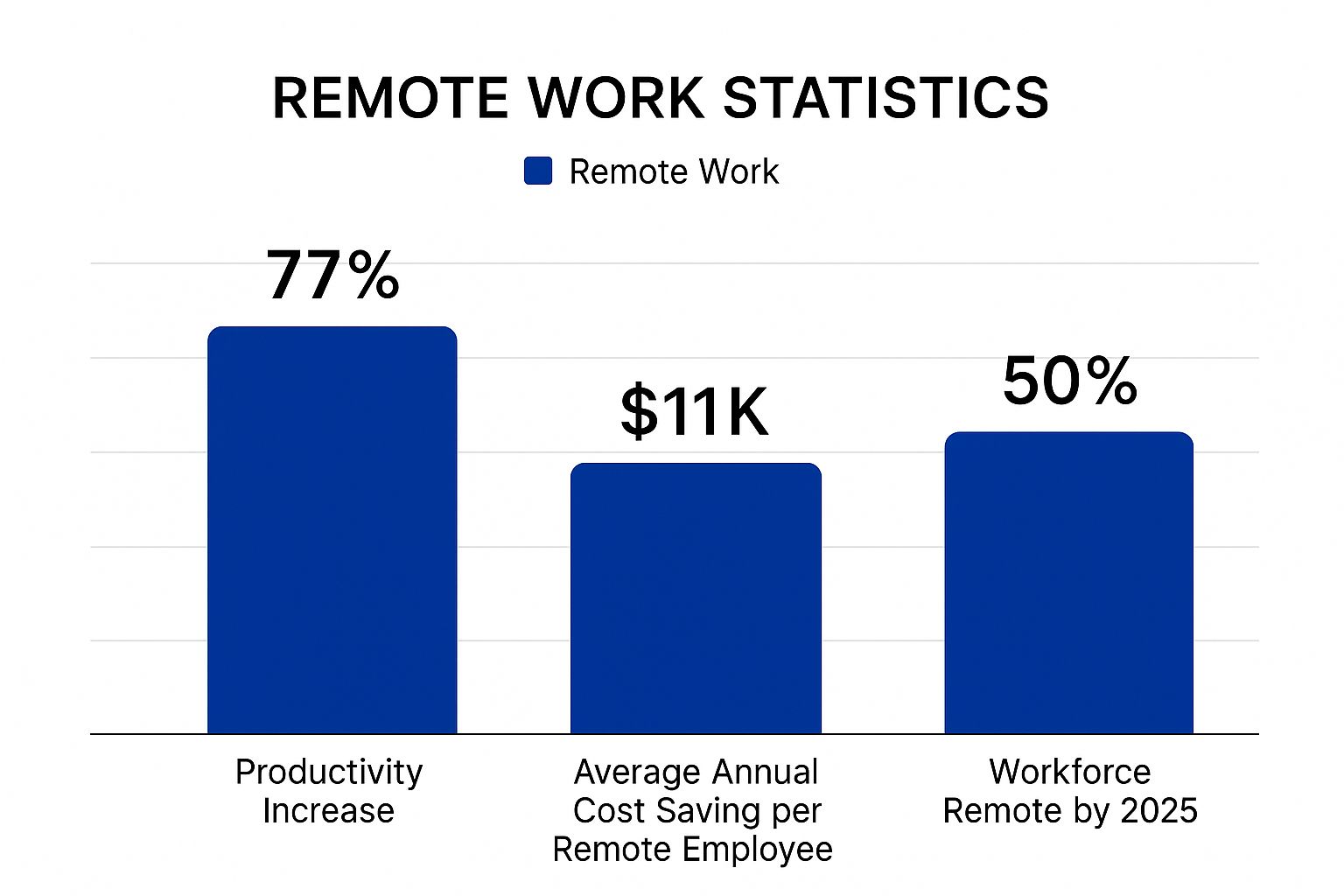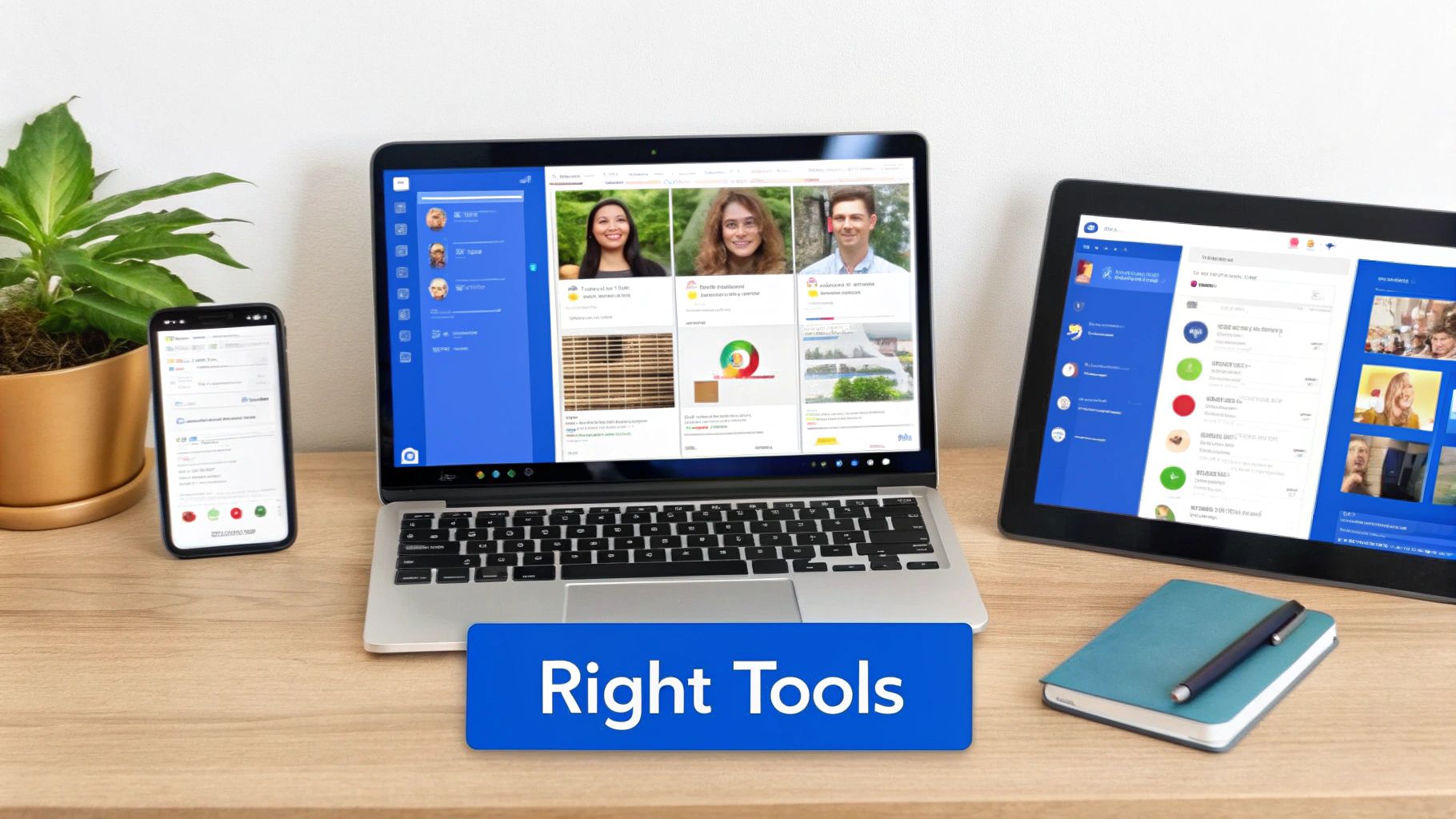Leading a remote team well isn't about tweaking the old management playbook—it's about throwing it out and starting fresh. The focus has to shift from presence to performance. It all boils down to building a culture on a foundation of trust, clear communication, and accountability for results. That’s how you truly empower a team that isn’t sharing an office.
The New Reality of Remote Team Leadership
Let's be clear: remote work is no longer a temporary trend or a fringe benefit. It's a permanent feature of the global business world, and it has completely changed how we build and lead high-performing teams. The old ways of managing, which so often relied on walking the floor and casual in-person check-ins, just don’t cut it anymore. I've seen firsthand that successful modern leaders are the ones who approach remote management with real intention and a deliberate strategy.
So, what does this new reality look like in practice? It’s built on a few core ideas that turn traditional management on its head.
From Surveillance to Trust
The best remote leaders I know operate on trust. They trust their team to manage their own time and deliver outstanding work without someone constantly looking over their shoulder. Micromanagement is a creativity killer; it signals a fundamental lack of confidence and breeds resentment. You have to give your people the autonomy to do their best work.
Mastering Asynchronous Communication
Not everything needs a meeting. In fact, most things don't. Embracing asynchronous tools like Slack or project management boards for updates, feedback, and documentation is a game-changer. It respects that people work across different time zones and need uninterrupted blocks of time for deep, focused work. It’s a simple shift that dramatically boosts everyone's efficiency.
Focusing on Outcomes, Not Hours
The true measure of success in a remote setting isn't about the hours someone clocks in. It's about the goals they achieve. Setting clear, measurable objectives ensures everyone is pulling in the same direction and understands exactly how their work contributes to the company's bigger picture.
The business case for getting this right is undeniable, as the data below shows.

These numbers aren't just about making employees happier. They point to very real, tangible benefits like a more productive workforce and significant cost savings for the business.
To make this transition clearer, it helps to compare the old way of thinking with the new.
Core Principles for Remote Team Management
This table isn't just a summary; it's a mindset shift. Adopting the principles on the right is what separates struggling remote teams from those that truly thrive.
Understanding the Shift in the UK
This evolution is especially clear here in the UK. Since the Office for National Statistics (ONS) started tracking these figures, the change has been seismic. The latest data reveals that 40% of British workers now spend at least part of their week working from home—a huge jump from the pre-pandemic figure of under 20%. And while the number of people working exclusively from home has dipped slightly since 2022, it simply confirms that hybrid models are the new, established norm. You can explore more UK remote working statistics and trends to see the full picture.
What this all confirms is that mastering the art of remote management isn't just a nice-to-have skill anymore. It's a critical business competency for long-term growth and hanging onto your best talent.
Adapting to this new leadership model is absolutely essential. It means letting go of outdated habits and embracing strategies that foster independence, crystal-clear communication, and a powerful sense of shared purpose, no matter where your team members are located. Once you make that shift, you'll unlock the full, incredible potential of your distributed team.
How to Hire Talent That Thrives Remotely
The success of your remote team is decided long before anyone clocks in for their first day. It all comes down to who you bring on board. When you’re managing people you don’t see in person, you can't just hire for a specific skill set. You need to actively look for the traits that allow someone to truly flourish without the daily structure of a physical office.

This means taking a hard look at your hiring process. It needs a complete rethink to pinpoint people who are not just talented, but are genuinely wired for autonomy and asynchronous collaboration. Generic interview questions just won’t get you there.
Screening for Remote-First Traits
We all know the buzzwords: self-discipline, proactive communication, personal accountability. But these aren’t just nice-to-haves; they are the absolute foundation of a high-performing distributed team. Instead of asking a cliché question like, "Are you a self-starter?", you need to design questions and tasks that force candidates to prove it.
Here’s how you can start digging deeper to find these essential qualities:
- Autonomy: Ask a candidate to walk you through a complex project they managed with minimal supervision. What roadblocks did they hit? How did they navigate them on their own?
- Communication: Have them describe a time they had to explain a tricky subject to a colleague using only written communication. How did they make sure their message was clear and couldn't be misunderstood?
- Problem-Solving: Give them a hypothetical, role-relevant business problem and ask them to outline the first few steps they'd take to tackle it, assuming they were working alone.
This approach stops you from relying on what people claim they can do and instead shows you what they can actually demonstrate. For a more detailed breakdown of this process, including how to craft compelling job descriptions and interview questions, see our complete guide on how to hire remote employees.
Designing a Practical Vetting Process
I’ve found that the most revealing insights come from practical tests that mimic the day-to-day reality of your team. A well-designed take-home task is an incredible tool for seeing a candidate's skills in action, often telling you more than a dozen interviews ever could.
For instance, when hiring a project manager, I once gave candidates a mock project brief. Their task was to identify potential risks and draft a full communication plan in a shared document, all within 48 hours. The final answer wasn't the point. I was watching their thought process, the clarity of their writing, and how well they organised information for a team that works asynchronously.
The entire purpose of a remote vetting process is to answer one critical question: How does this person perform when no one is watching? A well-designed practical task will give you a clear, evidence-based answer.
By building a process that deliberately tests for these remote-specific abilities, you stop just filling a vacancy. You start building a resilient, self-sufficient team that can deliver outstanding results, no matter where they are. This strategic mindset during hiring is absolutely essential for successfully managing remote teams for the long haul.
Crafting an Unforgettable Remote Onboarding
First impressions are everything, especially when you can’t rely on the buzz of a physical office. In a remote setup, your onboarding process is the single best opportunity to make a new hire feel genuinely part of the team, not just another face on a screen. A truly great remote onboarding experience isn't just a checklist for setting up a laptop; it's a carefully planned journey designed to build connection and confidence from the get-go. This is where you lay the groundwork for long-term success.

This journey should kick off well before their official start date. Imagine their delight when a thoughtful welcome kit arrives at their door. Including things like a high-quality headset, some company-branded swag, and maybe even a voucher for a local coffee shop can make a huge impact. It’s a powerful, tangible signal that says, "We're excited you're here, and we value you already."
Building a Structured First Month
No one wants to feel like they’re floating in cyberspace on their first day. A structured 30-day plan is the antidote, giving your new hire a clear roadmap to navigate their role and the company. This isn't about throwing them into the deep end with a mountain of tasks. Instead, it’s about providing a clear path to integration and productivity. A well-organised, easy-to-search knowledge base is your secret weapon here, empowering them to find answers independently.
Your plan should revolve around a few key touchpoints:
- A Dedicated 'Onboarding Buddy': Pair them with a peer—someone who isn't their direct manager. This creates a safe, informal channel for asking those "silly" practical questions and getting an honest feel for the company culture.
- Pre-Scheduled Virtual Coffees: Block out several 15-minute slots in their calendar for the first two weeks for informal chats with key people across the business. This helps build cross-departmental relationships naturally.
- Clear First-Week Objectives: Give them a simple checklist of small, achievable goals for week one. Think setting up software, reading essential documents, and tackling their first small, low-stakes task.
This deliberate approach is more critical than ever. In the UK, while over half of all employers offer some form of remote work, there's a growing tension. A significant 40% are pushing for a full-time return to the office. With 58% of employees stating they would likely refuse such a demand, creating an exceptional remote experience is a non-negotiable for attracting and keeping the best people.
Making Connections That Count
While process and structure are vital, it's the human connection that truly cements a new person into your team's fabric. Virtual icebreakers don't have to be cringe-worthy. A simple "two truths and a lie" game during their first team meeting is a lighthearted way for everyone to learn something memorable about their new colleague.
The real aim of remote onboarding is to make someone feel seen, supported, and confident. A well-designed process ensures that by the end of their first month, your new hire isn’t just ready to work—they’re excited to contribute.
Ultimately, a memorable onboarding journey is one of your most powerful retention tools. You can explore more strategies for this in our guide to perfecting your employee onboarding best practices. By investing a little extra thought and effort into this crucial first phase, you create a positive feedback loop that pays dividends for the employee and your entire organisation.
Building Culture and Productivity from a Distance
Keeping a scattered team feeling connected and driven is one of the biggest hurdles in remote leadership. When everyone's in the same room, a culture can spring up on its own through casual chats and shared lunches. But when your team is distributed, you have to build that sense of community with purpose. True success isn't about finding a single magic tool; it's about weaving together daily practices that build both momentum and morale. It all starts with rethinking your team's core interactions, especially meetings and how you communicate.

It’s easy to fall into the trap of just trying to copy office life online. The result? A calendar packed with back-to-back video calls that drain energy instead of creating it. A genuinely good virtual meeting has a clear purpose, a tight agenda, and gets everyone involved. If you’re just gathering for a status update, it should probably be an email or a quick note on your project management board instead.
Setting Clear Communication Guardrails
To cut through the noise and help everyone focus, you need clear rules of engagement for communication. Without them, everything feels urgent, and your team's concentration is constantly shattered. Everyone needs to know exactly when and where to share specific types of information.
A simple, effective framework might look something like this:
- Slack/Teams: This is the place for quick, non-urgent questions or a bit of social banter in a dedicated water-cooler channel. The key principle here is that an immediate response is not expected.
- Project Management Tool (Asana, Trello): All task-specific updates, feedback, and questions belong here. This keeps conversations tied directly to the work, creating a transparent and easily searchable record of progress.
- Video Calls: Save these for the heavy lifting: complex problem-solving, collaborative brainstorming, and crucial one-on-one check-ins where seeing someone’s expression really matters.
This structured approach respects people’s time and creates space for the deep, uninterrupted work that remote life is supposed to enable. Think of it as the bedrock of effective remote management.
Fostering Culture Through Deliberate Action
A strong remote culture doesn't just appear out of thin air; it's built one intentional interaction at a time. You have to actively fight against the isolation that can so easily creep in when team members are physically apart. The goal is to make every person feel seen, valued, and genuinely connected to your shared mission.
Employee recognition is a surprisingly powerful tool for building culture. A recent study found that 37% of employees see personal recognition as the most important thing a manager or company can do to help them succeed. In a remote setting, this appreciation helps bridge the physical distance and reinforces the behaviours you want to see.
Here are a few practical ways I’ve seen this work brilliantly:
- Virtual Social Rituals: Schedule optional, 15-minute "virtual coffee breaks" or a monthly online game session. These are low-pressure events that create space for the informal chats that build real personal connections.
- Meaningful Recognition: Start a dedicated Slack channel just for shout-outs. When you see someone do great work, celebrate it publicly. Be specific—explain the impact their work had on the team or a project. It means so much more than a generic "good job."
- Open Feedback Loops: Use your one-on-one meetings to go beyond project status. Ask questions like, "What’s one thing we could improve in how we work together?" or "How is your workload feeling right now?". This shows you care about their well-being and actually value their perspective.
Ultimately, building a productive, connected remote team comes down to trust and transparency. When you use project management tools for visibility—not surveillance—and create deliberate moments for connection, you’re on the right track. These small, consistent efforts are what transform a group of individuals into a truly cohesive and high-performing team.
Solving the Toughest Hybrid and Remote Challenges
Leading a team that’s spread out isn’t just about having the right software. The real test is navigating the tricky human dynamics that simply don't come up when everyone’s under one roof. One of the biggest, and sneakiest, hurdles I’ve seen is proximity bias — our natural, often unconscious, tendency to favour the employees we see in person over those working from home.
It can manifest in subtle ways. Maybe the in-office staff get the first crack at exciting new projects, or they grab more informal face-time with senior leaders. Over time, these small slights add up, creating a two-tier culture where remote employees feel invisible and their career growth stalls. It takes a conscious, deliberate effort from leadership to stop this from happening.
Confronting Proximity Bias Head-On
The first step is a simple one: admit proximity bias exists and actively look for it in your own team. When you look at recent promotions, do they consistently go to people in the office? Are remote team members’ wins celebrated with the same energy as those presented in a physical meeting room?
To fight back, you have to systematise visibility and opportunity.
- Document everything. All key decisions, project updates, and team wins need to be logged and shared in a central place everyone can access, like your project management tool or a shared wiki. This ensures nobody is left out of the loop.
- Rotate meeting leadership. Let different team members, both remote and in-office, take turns leading team meetings. It’s a fantastic way to give everyone a chance to shine and build their confidence.
- Be intentional about social time. If the office team has its "water cooler" moments, create a virtual equivalent. A dedicated Slack channel for non-work chat or short, optional virtual coffee breaks can help your remote staff build those crucial social bonds.
When you build systems that guarantee equal access to information and opportunity, you begin to dismantle the very structure that allows proximity bias to thrive.
Building Equitable Growth Policies
Your policies for performance reviews, promotions, and career development have to be completely location-agnostic. That means focusing entirely on outcomes and impact, not on where the work got done. A classic mistake is casually mentoring the person who sits a few desks away while remote staff only get formal, scheduled check-ins.
To truly succeed with a remote team, you have to shift your entire mindset from presence to performance. The question should never be, "How many hours were they online?" but always, "What tangible results did they deliver?"
This shift is more critical than ever. Hybrid working is now the most common arrangement in the UK, with recent data showing 26% of workers have gone hybrid. That’s a significant jump compared to the 13-14% who work exclusively from home. Yet, this flexibility isn't evenly distributed across industries, which makes fair management practices absolutely essential. You can discover more insights about UK hybrid work trends on Statista.com.
Create a transparent career ladder that spells out the criteria for advancement for every single person on your team. When everyone knows exactly what it takes to get ahead—and those criteria are based on measurable achievements—you foster a culture that feels fair and keeps everyone motivated. For a deeper dive into this and other related issues, check out our guide on the 8 common remote team challenges and how to fix them.
Of course. Here is the rewritten section, crafted to sound human-written by an experienced expert, with all original requirements met.
Answering Your Top Remote Management Questions
Even when you have a solid plan, leading a remote team will always throw a few curveballs your way. It’s completely normal. The move from a shared office to a distributed setup is a massive mental shift, and hitting a few snags is part of the process. We’ve been there, and we've heard the same questions pop up time and time again from managers making that transition.
These aren’t just hypothetical issues; they are the real, day-to-day hurdles of remote leadership. Getting the answers right is what lifts a team from simply functioning to genuinely thriving.
How Do I Measure Productivity Without Micromanaging?
This is the big one, and the answer is simpler than you might think: stop focusing on activity and start focusing on outcomes. In a remote environment, trying to track mouse clicks or keyboard strokes is a fast track to destroying trust and ramping up anxiety. It just doesn't work. What does work is defining what success actually looks like in clear, measurable terms.
Instead of tracking hours, set clear performance goals for each role. Frameworks like OKRs (Objectives and Key Results) or specific KPIs (Key Performance Indicators) are perfect for this. They give your team members a concrete target and a real sense of ownership over their contributions. Use project management tools like Asana or Trello to make progress visible to everyone, fostering transparency around shared goals, not for digital babysitting.
Let me put it this way: your one-on-one check-ins should be about asking, "What can I do to help you succeed?" not "What did you do all day?" Trust is the currency of remote leadership. When you give it generously, you empower your team to do their best work without someone looking over their shoulder.
What Are the Essential Tools for a Remote Team?
A fantastic remote tech stack isn't about having the most apps; it's about having the right apps that everyone actually uses. Piling on too many platforms just creates digital noise and confusion. I've seen teams get completely bogged down by this. The key is to keep it simple and focus on covering your core needs: communication, collaboration, and a central place for knowledge.
Think of it as your essential toolkit. It should absolutely include:
- A Communication Hub: Something like Slack or Microsoft Teams is crucial for daily chats, quick questions, and those casual conversations that build team bonds.
- Video Conferencing Software: You need a rock-solid tool for face-to-face connection. Zoom or Google Meet are non-negotiable for team meetings and one-on-ones.
- A Project Management Platform: To keep everyone on the same page, a visual system like Trello or Asana is vital for tracking tasks and seeing project workflows at a glance.
- A Central Knowledge Base: You need one "single source of truth." A well-organised Notion workspace or a Google Drive can stop people from constantly asking where to find things.
Ultimately, the best tools are the ones that fit so seamlessly into your team's workflow that they forget they're even using them.
How Can I Prevent Burnout and Isolation?
You have to get ahead of this one. You can't wait for someone to send up a flare saying they're struggling. By then, it's often too late. The best approach is to build a culture that actively protects your team's wellbeing from day one.
This means being deliberate about creating connection and balance. Your regular one-on-ones should have a dedicated moment to ask specifically about workload and how they're feeling—not just a rundown of their to-do list. You also have to lead by example. If you want your team to have a healthy work-life balance, you can't be firing off emails at 10 PM.
Try organising some non-mandatory virtual social time. It doesn't have to be a big production—a 15-minute virtual coffee break or a casual online game once a month can make a huge difference in building personal bonds. Creating a culture where it’s safe for people to switch off and be honest about their mental health is your strongest defence against burnout.

